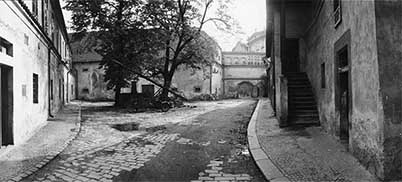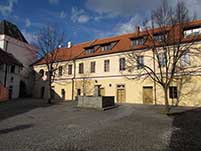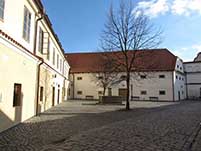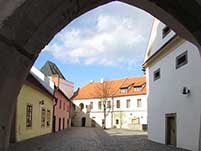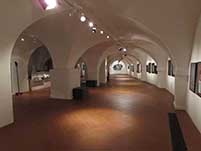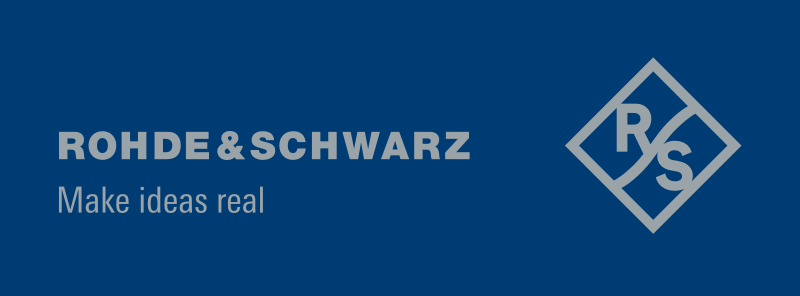Pardubice Příhrádek
A glance into the history and present days
Příhrádek (the Pardubice Castle outer ward) was gradually built within several construction stages. The oldest stage, before the House of Pernštejn took over (i.e. before 1491), is not documented at all. Transformation of Příhrádek into an outer farming and administration ward probably took place between years 1514 and 1516 – municipal houses of Jakub Vačkář, Jana Barvířka and the Slatter´s house – were put down at that time. In 1516, an external gate is recorded as leading to the Castle bridge called “the rampart”. The two-floor gate tower closed by two doors (in 1719 described as a "metal plated and severely worn out gate"). It was probably at the beginning of its existence when the gate keeper called “Gunner” was installed on the second floor. The recent replica of the splint roof obviously recalls the situation before 1538, when a two-floor arch attic was erected, which is still seen on the Willenberg´s veduta from the early 17th century. At that time, the whole Příhrádek was already fortified being connected to the municipal ramparts – a part of the wall is preserved at the back of house No. 5. The town gate dating back to the first stage was preserved (originally equipped with an access gallery), the outer ramparts, the whole ground floor of house No. 5 (including the transacted shouldered arch) and a two-floor through gate to the Castle. The documents from 1602 describe the judicial chamber located at the bridge where subjects were heard. After the fire in 1538, residential houses No. 6 and 7 were added on the gate which used to have gallery access. Their front walls were finished by gables whose bottom parts are still preserved. "A wooden rectangular bridge with a small chapel and crucifix in the middle lead from the Castle."
Old manuscripts explain that Příhrádek was inhabited by farm servants, town clerks; blacksmiths and cartwrights used to have their workshops in the area. The oldest documents mention an armament and gunpowder warehouse, as well as several domed stables with a timber corn-loft on its top dating back to the early 18th century. The outer wall was complemented by a large granary which then served as a wine distillery.
The recent fashion of Příhrádek was mostly formed by the reconstruction in the 19th century, when house No 8, the whole upper floor of house No 5 were newly built and the front walls of houses No 6 and 7 were adjusted. Two cusped portals for pedestrians were established at the municipal gate flanks after 1903 according to the plan of the Pardubice architect Boža Dvořák, upon request of the owner of the furniture warehouse in the granary.
In 1920, the Museum Alliance bought the Pardubice Castle real estate. Příhradek did not experience any major changes: in the period of the “First Republic” it mostly served as a residential area. On 10 May 1952, the whole premises were taken over by the Ministry of Education, Science and Arts. The Pardubice Castle including all the outer wards transferred into a large warehouse unit. The new project design predetermined Příhrádek for the use of the district archives. The granary was to serve as a depository, house No. 5 as a study room, etc. Eventually it was the Regional Centre of the State Heritage Preservation and Environment Protection (today the National Heritage Institute) who took the premises over and in 1967 established the restoration studio. In the next stage a major reconstruction followed according to the design by A. Charvátová of SURPMO (the State Institute of National Heritage Reconstruction).
The recent period witnessed the last reconstruction of house No. 5 for the needs of the local branch of the National Heritage Institute and of the Granary, the latter now used for various cultural events. The lecturing hall on the ground floor is used in cooperation with the University of Pardubice.
The reconstructed Granary, now administered by the National Heritage Institute, host the Gallery of the City of Pardubice, newly established by the Statutory City of Pardubice and operated by the Cultural Centre of Pardubice. The exhibition programme Gampy currently presents the contemporary Czech artists in the regional and European context. Its mission is to focus on topical issues in arts and society. The exhibition premises of the ”Kunsthalle” type change the visiting authors projects every two months. The institution does not sell art, nor is it involved in acquisitions. The Communication Area hosts accompanying exhibitions of an information, student, amateur and experimental nature. Among the most popular exhibitions list presentations of František Kyncl, Josef Procházka, Alva Hajn, Skupina 11 and Radek Kalhous.
